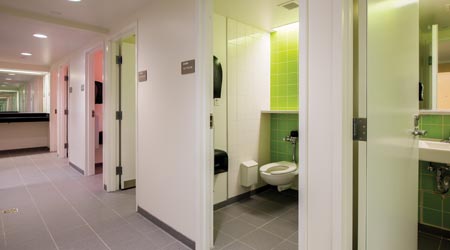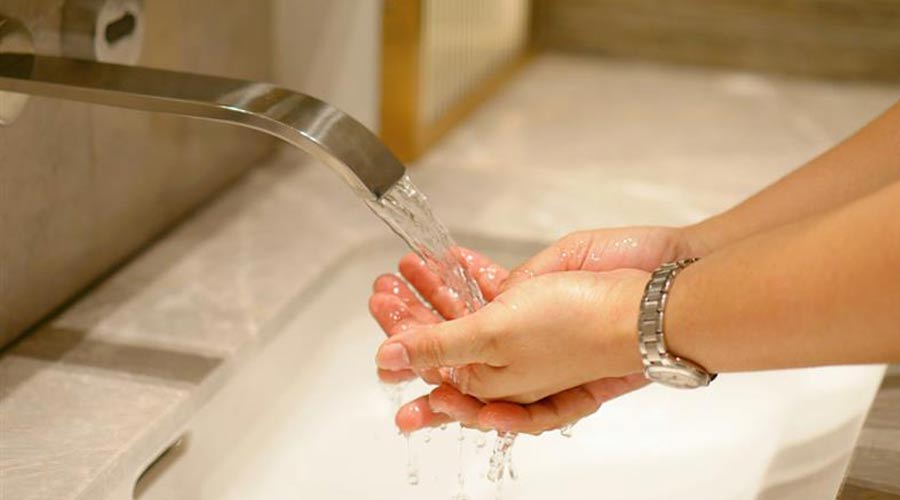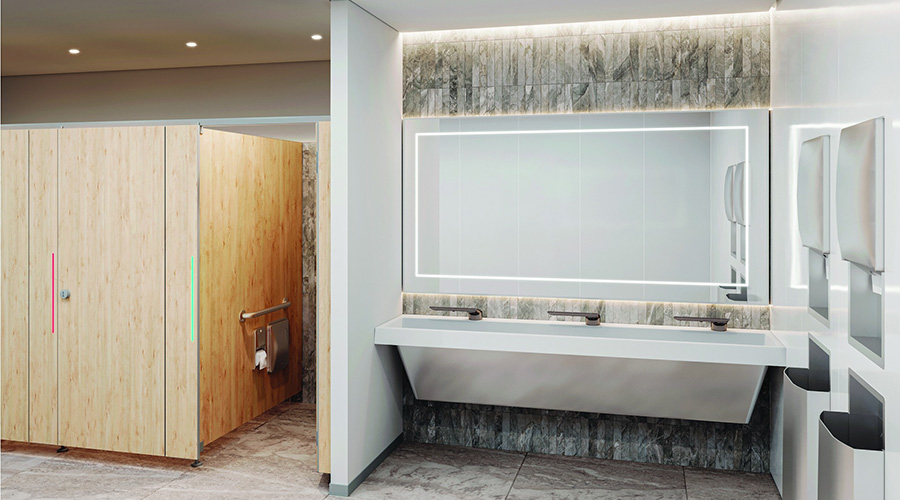 At the University of Pennsylvania, a newly renovated residence hall incorporates gender-neutral, single-occupant restrooms. Elsewhere at the school, changing existing single-user restrooms to gender-neutral facilities was mainly a matter of signage.Aislinn Weidele for Mills + Schnoering Architects
At the University of Pennsylvania, a newly renovated residence hall incorporates gender-neutral, single-occupant restrooms. Elsewhere at the school, changing existing single-user restrooms to gender-neutral facilities was mainly a matter of signage.Aislinn Weidele for Mills + Schnoering ArchitectsHow To Overcome Obstacles, Resistance to Gender-Neutral Restrooms
Questions of cost, fixture choices, and education remain for FMs considering gender-neutral restrooms.
Even as single-occupant, often gender-neutral, restrooms become more popular, it’s not clear how prevalent they will become. One significant challenge is cost. “They’re going to be more expensive,” Koshley says. The drywall needed to create a single-occupant restroom is more expensive than partitions. In addition, each restroom requires a floor drain; in a typical restroom, one floor drain is available for multiple fixtures.
The expense can be particularly steep when existing buildings are renovated to incorporate single-occupant restrooms. For instance, a hotel or lodge that adds a single-occupant restroom in a public area often will have to convert prime space, such as part of a restaurant, to a restroom, and spend tens of thousands of dollars, says Bob Holesko, corporate director of engineering with Great Wolf Resorts, a chain of indoor water parks and hotels.
Verboomen says that it’s likely a tipping point exists. For instance, it may be possible to create two single-occupant restrooms in about the same space that a multi-stall restroom with two stalls would require. But, in larger facilities that require, for instance, a dozen toilets, it’s unlikely twelve single rooms could be designed to require no more space than a multi-stall restroom with twelve stalls.
Throughput is another issue, Verboomen notes. In a multi-stall restroom, as soon as one individual exits a stall to wash his or her hands, another individual can enter it. In a single-occupant restroom, the user typically remains in the room to wash his or her hands, preventing anyone else from entering. As a result, the number of single-occupant restrooms required may be more than the number of stalls needed.
When choosing fixtures and finishes for a gender-neutral restroom, the general rule is to try to remain consistent with the other restrooms in the building. This keeps the user experience consistent and streamlines maintenance.
One benefit of individual restrooms when it comes to cleaning: The staff doesn’t have to shut down an entire fleet of stalls. In addition, either a male or female custodian can clean a gender-neutral restroom.
Other questions
Outfitting a gender-neutral restroom can prompt questions that tend not to arise with gender-specific restrooms. One is whether to include a urinal. “If they’re not including one, are they limiting the perception of who the restroom is for?” Niebauer asks. He adds that many gender-neutral restrooms he’s seen don’t include them.
With gender-neutral restrooms, the hardware used to signify whether the room is occupied or not can become even more critical, Verboomen says. If an individual accidentally opens a door when the room is in use and the two people are not of the same gender, the encounter may become uncomfortable and possibly angry.
Once a restroom is designated gender-neutral, how should facility managers signal this to occupants? “Make it easily identifiable to people that it’s a gender-neutral restroom,” Niebauer says. Options include signs that include pictograms for both men and women, or that simply say, “Restroom” or “All Gender Restroom.”
Koshley says he recently was in a restaurant in which the single-occupant restrooms simply indicated whether it contained a toilet, a urinal, or a toilet and a sink, he says. “The stalls were ‘advertised’ by function, not by gender,” he says.
Gender-specific restrooms still popular
Even as the number of gender-neutral restrooms grows, albeit from a tiny base, gender-specific restrooms remain popular. Owensboro Health, Inc., in Owensboro, Ky., recently renovated a major portion of its Parrish campus for its IT group of about 100 employees, says Joseph Taylor, executive director of facilities. The renovation included two single-occupant restrooms near a cafeteria. Initially, the rooms were unisex, as the employee base is fairly evenly split between men and women, Taylor says.
However, employees indicated they preferred the rooms be designated as either for males or females. Some women reported that the restrooms tended not to stay as clean when both genders were using them. “So we converted unisex back to male and female,” Taylor says. “It was an interesting twist on the whole issue.”
The cost of incorporating gender-neutral, single-occupant restrooms also is a concern, particularly in existing buildings that require renovation. “We want to do the right thing for everyone, but we only have one pool of money,” Taylor says. “We’re first going to put that toward the clinical environment.”
Dave Moulton is director of mountain operations with Mount Snow, a four-season mountain resort in Vermont. The resort has an active website for season pass holders, he says. “We get lots of feedback and I can’t recall ever getting any feedback” on the issue of gender-neutral restrooms. Most skiers’ primary concern is simply a restroom that’s clean, he adds.
Karen Kroll, a contributing editor for Building Operating Management, has written extensively about real estate and facility issues.
Email questions to edward.sullivan@tradepress.com.
Related Topics:














